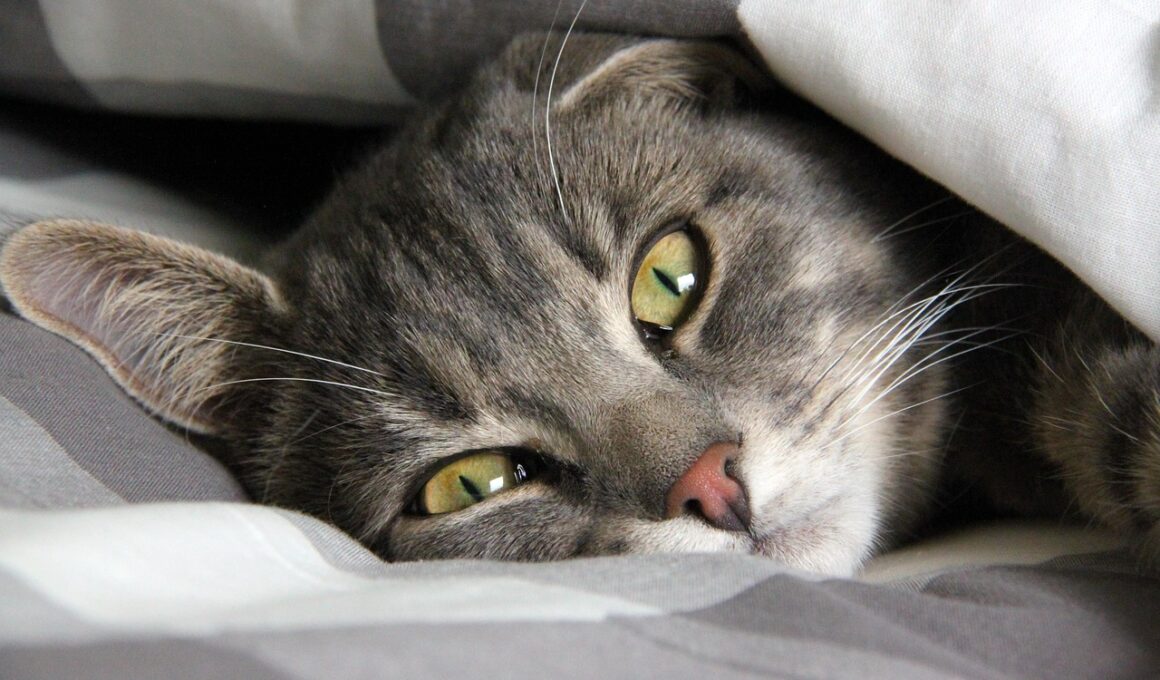Signs Your Cat Is Recovering from Hypothermia
Hypothermia is a severe condition affecting cats, especially during cold weather. It is important to identify the signs that your cat shows when recovering from hypothermia. Initially, when a cat exhibits signs like shivering, lethargy, or lack of appetite, immediate intervention is necessary. As the temperature gradually returns to normal, your cat may display behavioral changes indicating recovery. Look for signs like increased interest in surroundings and improved mobility. These could be indicators that their body temperature is stabilizing. Properly warming your cat involves wrapping them in blankets or using warmed water packs. Be cautious not to apply heat directly or too quickly, as it may lead to burns. You should consult a veterinarian for specific recovery protocols to ensure proper healing. Meanwhile, monitor your cat’s hydration levels, as dehydration commonly occurs with hypothermia. Offer warm water or watered-down food to maintain their energy levels. Early detection and consistent monitoring increase the chances of a full recovery, so if any concerning signs persist, contact your vet immediately for further advice. Remember, your cat’s well-being depends on your attentive care during this critical time.
It is essential to understand the various recovery phases after your cat experiences hypothermia. Once stabilized, a noticeable change in temperature can be observed when holding them; they might feel warmer. Active grooming behavior is another strong sign of recovery. Cats groom themselves to restore body heat and their energy levels. Watch for them seeking out cozy places, like small spaces where they can burrow into blankets or cushions. Increased purring often indicates comfort and security, suggesting your cat feels better. Look for subtle but positive changes in their appetite. A cat recovering from hypothermia might show interest in eating again, even if it is smaller portions at first. Offer easily digestible food to help replenish lost energy without overwhelming their system. Remember to maintain a warm environment, free from drafts. Soft, low-light conditions help reduce stress, allowing your cat to regain strength. Also, offer companionship. Your presence can be reassuring for your cat during recovery, building their confidence. Gradually increase their activity levels to promote muscle tone and strength. Every small sign of improvement contributes to overall recovery while ensuring your cat feels safe and loved during this challenging time.
Monitoring Vital Signs
Closely monitoring vital signs like heart rate and breathing can greatly aid in assessing recovery. A normal cat heart rate is between 140 to 220 beats per minute. If your cat’s heart rate begins to normalize, it indicates improvements. Record the values before and after intervention. Alongside heart rate, observe respiratory patterns. Rapid shallow breathing could signify distress, while slower, deeper breaths indicate better oxygen distribution. Keep an eye on gum color; pink, moist gums suggest healthy circulation, whereas pale or blue gums are concerning. When a cat is recovering, their responsiveness increases significantly. Your cat might begin to show interest in their usual activities, such as playing or interacting with family members. Pay attention to their communication; soft meows can indicate a positive turning point. However, if your cat exhibits aggression or signs of pain, it may suggest ongoing issues. Continuous monitoring, especially in the first few days post-treatment, is crucial. Recheck their body temperature at regular intervals and consult your veterinarian for anything alarming. Involving your vet can provide a tailored recovery plan that better addresses individual circumstances. Personalized care makes all the difference in a cat’s healing journey and recovery process.
Speedy recovery signs include social behavior returning to normal. Cats are generally solitary creatures but may actively seek companionship during the recovery phase for reassurance. By returning to their usual routines, you will see a positive transition. If your cat approaches you for affection or appears more playful, it signals improvement. As they recover, you may also notice grooming behaviors returning—showing they are regaining confidence and self-care. Monitoring litter box habits is also critical; a cat resuming normal bathroom habits indicates their body is functioning well. Watch for regular urination and bowel movements, as complications such as constipation can arise following hypothermia. Ensure your cat is staying hydrated too by checking water intake daily. If hydration improves, it’s another positive sign of overall recovery. Once your veterinarian clears them for increased activity, gradually introduce short play sessions to engage their mind and help regain physical strength. Toys that stimulate both mental and physical activity will help motivate your cat to move. Each positive behavior reinforces their recovery journey, contributing to their emotional and physical healing. Celebrate these moments, as every little sign of wellness can uplift both you and your beloved feline companion.
Environmental Considerations
Providing a warm, safe environment plays a crucial role in your cat’s recovery from hypothermia. Ensure the recovery area has minimal drafts, keeping it cozy and secure. Creating a designated space with blankets or bedding can help your cat feel safe and comfortable. Incorporate heating pads under a blanket or towel, ensuring they do not get too hot. You can also create a small environmental barrier, like a cat tent or box to enhance their safety. This way, your cat will become accustomed to their recovery area, reducing stress levels. Soft ambient lighting can also provide a soothing atmosphere. Avoid loud noises or chaotic environments during this period. An environment free of stress encourages a better recovery process. Additionally, limit any interactions with other pets, especially if they are overly playful or aggressive, as this can overwhelm your recovering cat. Surveillance during this time is also key—monitor signs of discomfort closely. Keep any items like food, water, and litter boxes within easy reach, reducing your cat’s need to exert themselves. Tailored environmental care will help your cat focus on recuperating, allowing their body to heal steadily and sustainably.
Regular check-ins with your veterinarian should remain a priority throughout the recovery period. If any signs recur, contacting your vet could prevent complications. They will help assess your cat’s ongoing recovery and recommend adjustments to treatment. During these check-ins, share any observations concerning appetite, energy levels, or attitude. Your vet will appreciate your detailed notes, as they help track your cat’s progress systematically. After assessing the situation closely with your vet’s guidance, they may suggest supplementary treatments or therapies. Follow up about any specific concerns regarding hydration or nutrition, especially if your cat was dehydrated initially. Remain dedicated to adjusting their feeding schedule if necessary, ensuring they receive the appropriate nutritional support. Therapeutic play or monitored exercise may be suggested to aid in regaining movement. Incorporate quality time to strengthen your bond and alleviate anxiety. Your engagement enhances your cat’s emotional healing. Be aware of any long-term behavioral changes, as hypothermia can create lasting impacts. Document these observations for future consultations. Ensuring that you create a comprehensive recovery plan alongside your vet reinforces your cat’s chances of a full recovery, contributing to a happier, healthier feline friend.
Final Thoughts on Recovery
Every cat’s recovery from hypothermia is a process that requires patience and attentive care. The journey back to health may present unique challenges and progress indicators. As a cat owner, your active involvement makes a significant difference. Recognize that each recovery stage may take time, depending on the severity and duration of hypothermia. Be prepared for setbacks, and remain observant about your cat’s general demeanor. Celebrate each recovery milestone, no matter how minor, as these indicate improving health. Maintaining open lines of communication with your veterinarian will provide critical support when needed. Discuss any changes or concerns as they arise, fostering a comprehensive understanding of your cat’s needs. Always lean into your knowledge and instincts as a loving pet owner, assessing situations as they develop. Your cat’s emotional state is as important as their physical health; your affection will support both. At times, cats may not respond positively to care, so remain calm, gentle, and supportive throughout their recovery. With your love and vigilance, your cat can overcome this hurdle and return to its spirited self once again. Patience and persistence will pay off immensely as they recuperate and reclaim their joyful lives.
Understanding the recovery indicators helps ensure that you are fully equipped to assist your cat back to health. Remember that each journey varies by individual, and timelines can differ. Significantly, providing consistent, gentle care fosters tremendous improvement. Monitor your cat actively, paying attention to subtle changes in their behavior, and maintain open communication with your veterinarian to devise the best recovery strategy built on professional guidance. Carefully navigating through stressors over the recovery phase will strengthen your bond with your cat as they heal. More than just attending to their physical needs, emotional support plays a pivotal role in their recovery. Your attentiveness inspires a trusting environment for your cat. Regular interactions will guide them back to comfort. Be observant to recognize unique needs throughout the healing process, as this will assist in more effective treatment plans. Understanding that each recovery entails challenges will prepare you for possible ups and downs, further ensuring that you offer balanced support. A strong commitment combined with love can enable your cat’s return to health, happiness, and vitality. Celebrate the little victories along the way, as they reflect the strength of the bond you share. Together, you and your feline will overcome this testing time.


